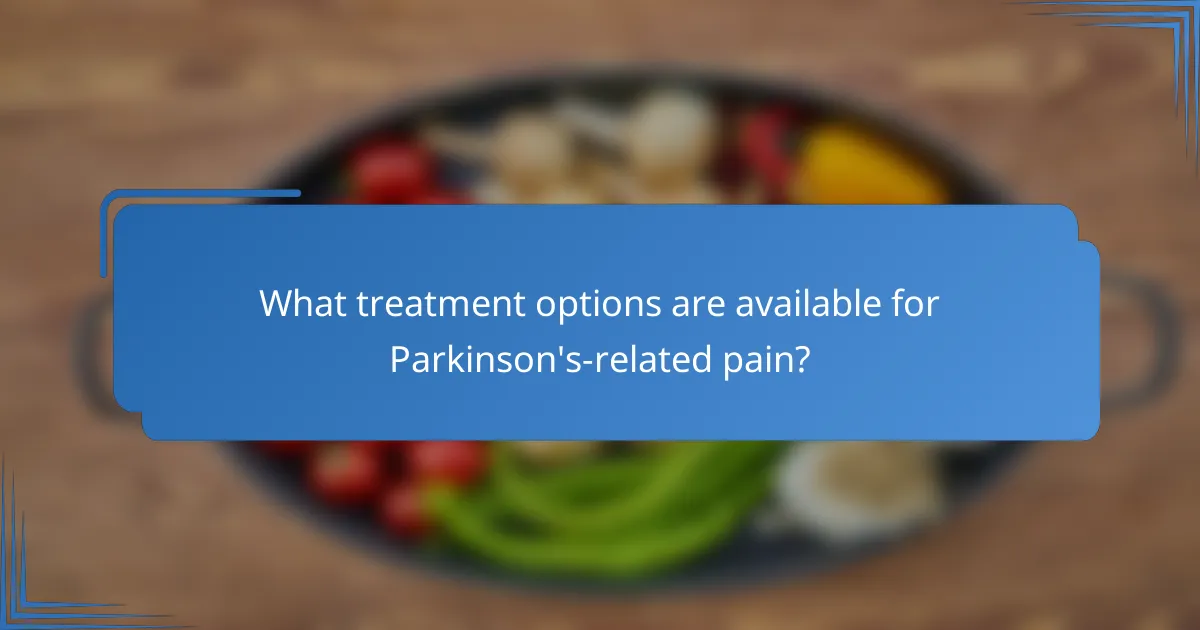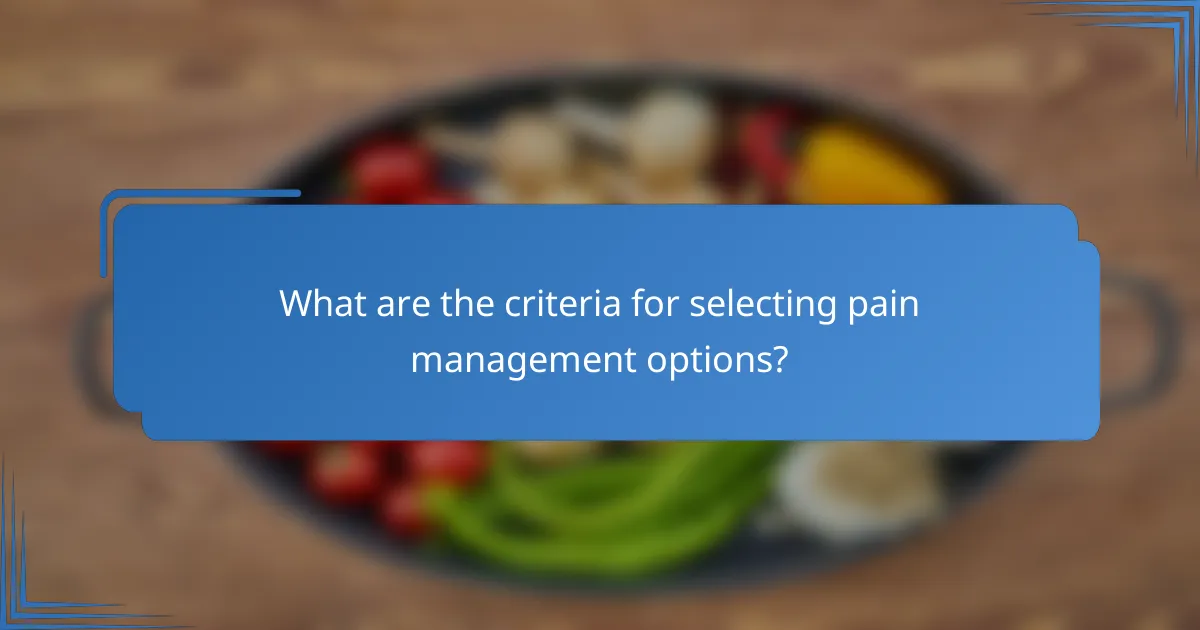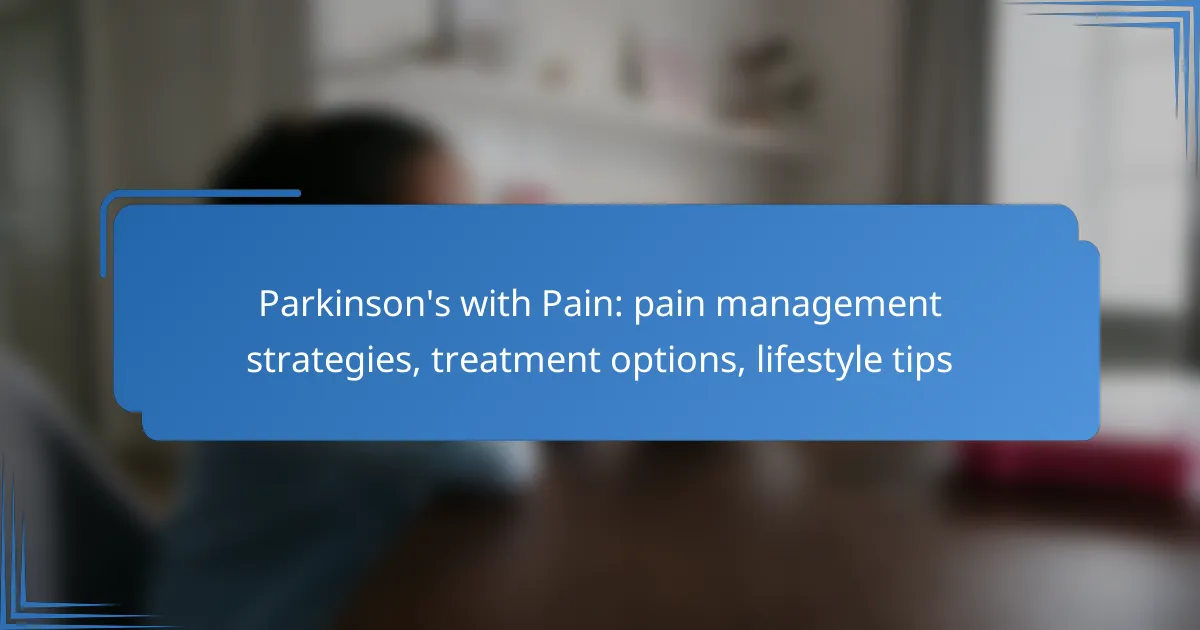Pain management for individuals with Parkinson’s disease is crucial for enhancing their quality of life. A comprehensive approach that includes medication adjustments, physical therapy, and lifestyle modifications can effectively alleviate discomfort. By incorporating regular exercise, a balanced diet, and stress management techniques, patients can experience significant improvements in their overall well-being.

What are effective pain management strategies for Parkinson’s in New Zealand?
Effective pain management strategies for Parkinson’s in New Zealand include a combination of physical therapy, medication adjustments, and lifestyle changes. These approaches aim to alleviate discomfort and improve overall quality of life for individuals living with Parkinson’s disease.
Physical therapy
Physical therapy is a key component in managing pain associated with Parkinson’s. Therapists can design personalized exercise programs that improve mobility, strength, and flexibility, which may help reduce pain levels. Regular sessions can also enhance balance and coordination, minimizing the risk of falls.
In New Zealand, accessing physical therapy services is often covered by the public health system, but waiting times can vary. Patients should seek a qualified physiotherapist experienced in neurological conditions for the best outcomes.
Medication adjustments
Medication adjustments can significantly impact pain management for those with Parkinson’s. Commonly prescribed medications, such as dopaminergic agents, may need to be fine-tuned to address pain effectively. Consulting with a neurologist or a pain specialist can help determine the right balance of medications.
In New Zealand, patients should be aware of the potential side effects of medications and discuss any concerns with their healthcare provider to ensure optimal pain relief without compromising overall health.
Occupational therapy
Occupational therapy focuses on enabling individuals to engage in daily activities while managing pain. Therapists can provide strategies to modify tasks and recommend adaptive tools that reduce strain on the body. This can lead to improved function and decreased discomfort.
In New Zealand, occupational therapy services are often available through public health, making it accessible for many patients. Regular assessments can help adjust strategies as the condition progresses.
Mindfulness and relaxation techniques
Mindfulness and relaxation techniques can play a crucial role in pain management for Parkinson’s patients. Practices such as meditation, deep breathing exercises, and yoga can help reduce stress and enhance emotional well-being, which may indirectly alleviate pain.
Incorporating these techniques into daily routines can be beneficial. Patients might consider joining local classes or using online resources to learn effective practices tailored to their needs.
Support groups
Support groups provide a valuable resource for individuals with Parkinson’s and their families. Sharing experiences and coping strategies can help alleviate feelings of isolation and provide emotional support. These groups often discuss pain management techniques and share insights on navigating the challenges of the disease.
In New Zealand, various organizations offer support groups, both in-person and online. Connecting with others facing similar challenges can empower patients and enhance their pain management journey.

What treatment options are available for Parkinson’s-related pain?
Managing Parkinson’s-related pain involves a combination of prescription medications, over-the-counter pain relievers, alternative therapies, and neuromodulation treatments. Each option has unique benefits and considerations that can help improve quality of life for those affected.
Prescription medications
Prescription medications for Parkinson’s-related pain typically include opioids, muscle relaxants, and certain antidepressants. Opioids can effectively manage severe pain but carry risks of dependency, so they should be used cautiously and under strict medical supervision.
Antidepressants, such as duloxetine, can also help alleviate pain by affecting neurotransmitter levels. It’s essential to consult with a healthcare provider to determine the most appropriate medication based on individual pain levels and overall health.
Over-the-counter pain relievers
Over-the-counter pain relievers like acetaminophen and nonsteroidal anti-inflammatory drugs (NSAIDs) can provide relief for mild to moderate pain. These medications are generally accessible and can be effective for managing discomfort associated with Parkinson’s.
However, it’s important to follow dosage instructions carefully and be aware of potential side effects, especially for long-term use. Consulting with a healthcare professional before starting any over-the-counter medication is advisable.
Alternative therapies
Alternative therapies, such as acupuncture, massage, and physical therapy, can complement traditional pain management strategies. Acupuncture may help reduce pain by stimulating specific points in the body, while massage can alleviate muscle tension and improve circulation.
Physical therapy focuses on exercises tailored to enhance mobility and strength, which can indirectly reduce pain. Always consult with a qualified practitioner to ensure these therapies are appropriate for your specific condition.
Neuromodulation treatments
Neuromodulation treatments, including transcutaneous electrical nerve stimulation (TENS) and spinal cord stimulation, are options for managing chronic pain. TENS uses electrical impulses to disrupt pain signals, while spinal cord stimulation involves implanting a device that alters nerve activity.
These treatments can be beneficial for individuals who do not respond well to conventional pain relief methods. A thorough evaluation by a specialist is necessary to determine the suitability and potential effectiveness of these interventions.

How can lifestyle changes help manage pain in Parkinson’s patients?
Lifestyle changes can significantly alleviate pain in Parkinson’s patients by promoting physical well-being and emotional resilience. Implementing regular exercise, a healthy diet, good sleep hygiene, and effective stress management can enhance overall quality of life and reduce discomfort.
Regular exercise
Engaging in regular exercise is crucial for managing pain in Parkinson’s patients. Activities such as walking, swimming, or yoga can improve flexibility, strength, and balance, which may help reduce pain levels. Aim for at least 150 minutes of moderate aerobic activity weekly, broken down into manageable sessions.
Incorporating stretching and strength training can further enhance mobility and alleviate muscle stiffness. Always consult a healthcare provider before starting a new exercise regimen to ensure safety and appropriateness.
Healthy diet
A healthy diet can play a vital role in managing pain for those with Parkinson’s. Focus on a balanced intake of fruits, vegetables, whole grains, lean proteins, and healthy fats. Foods rich in omega-3 fatty acids, like fish and flaxseeds, may help reduce inflammation and pain.
Staying hydrated is equally important; aim for around 2 liters of water daily, adjusting based on individual needs. Consider consulting a nutritionist to tailor dietary choices to specific health requirements and preferences.
Sleep hygiene practices
Good sleep hygiene is essential for pain management in Parkinson’s patients. Establishing a consistent sleep schedule, creating a comfortable sleep environment, and avoiding stimulants like caffeine before bedtime can enhance sleep quality. Aim for 7-9 hours of restful sleep each night.
Incorporating relaxation techniques, such as deep breathing or meditation, can also promote better sleep. If sleep disturbances persist, discussing options with a healthcare provider is advisable.
Stress management techniques
Effective stress management can significantly impact pain levels in Parkinson’s patients. Techniques such as mindfulness, meditation, and gentle yoga can help reduce stress and improve emotional well-being. Setting aside time each day for relaxation can be beneficial.
Consider joining support groups or engaging in activities that foster social connections, as these can provide emotional support and reduce feelings of isolation. Regularly practicing stress-reduction strategies can lead to long-term improvements in pain management.

What are the criteria for selecting pain management options?
Selecting pain management options for individuals with Parkinson’s involves evaluating several key criteria. These include the severity of pain, the patient’s overall health, and their response to previous treatments, which can guide healthcare providers in tailoring effective strategies.
Severity of pain
The severity of pain is a primary factor in determining management options. Pain can range from mild discomfort to severe, debilitating pain, influencing the choice of treatment. For mild pain, over-the-counter medications may suffice, while more severe pain might require prescription medications or advanced therapies.
It’s essential to assess pain regularly using a scale from 0 to 10, where 0 indicates no pain and 10 represents the worst pain imaginable. This assessment helps in adjusting treatment plans effectively.
Patient’s overall health
A patient’s overall health significantly impacts pain management strategies. Factors such as age, comorbidities, and current medications can affect how a patient responds to pain treatments. For instance, older adults or those with liver or kidney issues may need lower doses of medications.
Additionally, lifestyle factors like diet, exercise, and mental health can influence pain perception and management. A holistic approach that considers these aspects often leads to better outcomes.
Response to previous treatments
Evaluating how a patient has responded to previous treatments is crucial in selecting future pain management options. If a patient experienced significant relief from a particular medication or therapy, it may be beneficial to continue or adjust that approach.
Conversely, if a treatment resulted in adverse effects or minimal relief, alternatives should be considered. Keeping a detailed record of treatment responses can help healthcare providers make informed decisions moving forward.

What emerging trends are shaping Parkinson’s pain management?
Emerging trends in Parkinson’s pain management focus on innovative technologies and personalized approaches that enhance patient care. These strategies aim to improve pain relief while considering individual patient needs and preferences.
Telehealth consultations
Telehealth consultations are becoming increasingly popular for managing pain in Parkinson’s patients. They allow for remote assessments and follow-ups, making it easier for patients to access care without the need for travel. This can be particularly beneficial for those with mobility issues.
During a telehealth session, healthcare providers can evaluate symptoms, adjust medications, and recommend therapies. Patients should ensure they have a reliable internet connection and a quiet space for these consultations to maximize effectiveness.
Wearable pain management devices
Wearable pain management devices, such as transcutaneous electrical nerve stimulation (TENS) units, are gaining traction among Parkinson’s patients. These devices deliver electrical impulses to help alleviate pain and can be used at home, providing convenience and flexibility.
Patients should consider the comfort and ease of use of these devices, as well as their compatibility with other treatments. Regular monitoring of pain levels while using these devices can help in assessing their effectiveness.
Personalized medicine approaches
Personalized medicine approaches in Parkinson’s pain management involve tailoring treatments based on individual genetic, environmental, and lifestyle factors. This can lead to more effective pain relief strategies that are specifically suited to each patient’s unique situation.
Patients should engage in discussions with their healthcare providers about genetic testing and other assessments that can inform treatment plans. Keeping track of symptoms and responses to different therapies can help refine these personalized approaches over time.
